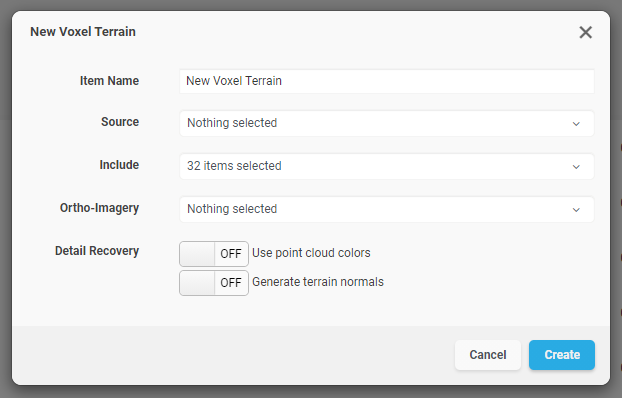Voxel Terrain
The Voxel Terrain entity represents volumetric terrain. It features a continuous surface, so it is ideal for rendering terrain surfaces. Also, since the entity is fully volumetric, it can be used as an operand in complex volumetric queries like detecting volume changes from one dataset to another.
It is possible to create Voxel Terrain entities from point clouds and heightmaps. Voxel Terrain entities can also have Ortho-Imagery sets associated with them. These sets can be supplied by the user (like aerial photography) or computed by the Voxel Farm system (like detail normal maps).
To create a new Voxel Terrain entity, click on “Voxel Terrain” from the “Add” menu. You will see the following options:

|
Item Name |
A readable name for the new entity |
|
Source |
Shows a list of available raw Point Cloud and Heightmap entities. From this list, you can select which entity will be used to construct the Voxel Terrain. It is possible to select more than one entity here. |
|
Include |
Allows to select which point classes should be used. By default, all points will be used to construct the terrain. This setting is used only when the source is a Point Cloud. |
|
Ortho-Imagery |
Shows a list of available Ortho-Imagery entities. If an Ortho-Imagery entity is provided, it will be processed into the Voxel Terrain dataset and later it can be visualized on top of the Voxel Terrain surface. It is possible to select more than one entity here. |
|
Detail Recovery – Use point cloud colors |
Applicable when creating a Voxel Terrain from a raw point cloud that contains RGB color information per point. If this option is checked, the import process will create an ortho-imagery set on-the-fly using point colors and it will apply it to the Voxel Terrain. |
|
Detail Recovery – Generate terrain normals |
Requests the import system to create another Ortho-Imagery set associated with the Voxel Terrain. This set will contain high-frequency elevation detail captured as a normal map. |
Click on “Create” to begin the voxelization process. You can track the upload operation from the “Pending” section in the project’s page
Once the processing is complete, you can view the new entity by clicking on the “View” button in the entity’s row inside the Catalog section for the project. Alternatively, you may create a View entity that uses the newly created entity as a source dataset.